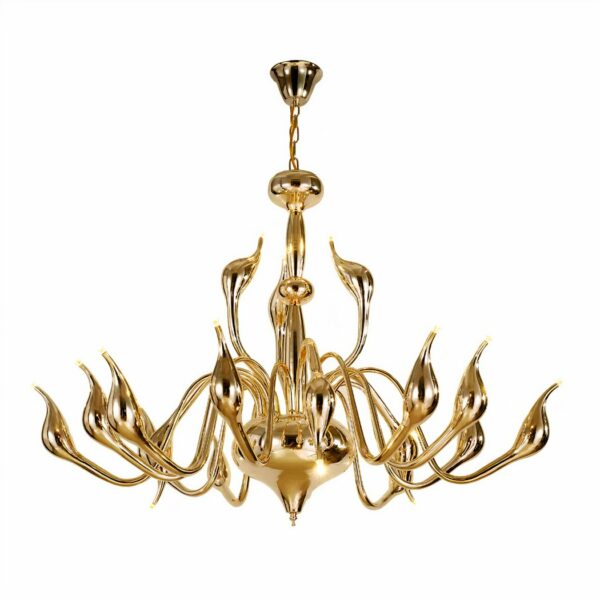Showing the single result
Showing the single result
The magic of Moroccan style
Unique features of Moroccan chandeliers: patterns and colors
Moroccan chandeliers are distinguished from a Japanese chandelierby their unique patterns and colors, which reflect the cultural richness of Morocco. These hanging pieces are often adorned with intricate geometric patterns, floral designs, and arabesque motifs, illustrating the influence of Islamic art.
Colors also play a crucial role, with hues ranging from deep blue and emerald green to vibrant red and glittering gold. These patterns and colors are not simply decorative; they tell a story, evoking the bustling souks, opulent palaces and desert landscapes of Morocco. Each chandelier is an invitation to travel through oriental history and Moroccan culture, bringing warmth, color and character to any space.
Creation of lighting fixtures following the artisanal style
The creation of Moroccan chandeliers follows an ancestral artisanal process, where each piece is handcrafted with meticulous attention to detail. Artisans use traditional techniques, such as metal chasing, glass blowing and engraving, to create unique works of art. This process not only maintains centuries-old traditions, but also ensures that each luminaire is a one-of-a-kind piece.
The materials used, such as copper, brass, wrought iron and colored glass, are chosen for their quality and durability. By choosing a Moroccan chandelier, you bring not only a decorative piece to your home, but also a fragment of Morocco’s artistic and cultural heritage.
Authentic materials rich in history
The elegance of metal in Moroccan craftsmanship
The use of metal, particularly copper, in Moroccan chandelier craftsmanship is a testament to the elegance and finesse of this art. Moroccan craftsmen master the technique of working copper to create lamps with complex, delicate designs. These lights, often hammered and engraved by hand, are distinguished by their bewitching motifs and glossy or patinated finish. The copper chandelier, with its warm hue and subtle sheen, is particularly appreciated for its ability to add a touch of opulence and sophistication to any space, while diffusing a warm, welcoming light.
Diversity of materials: from metal to glass and straw
The diversity of materials used in Moroccan lighting fixtures is another remarkable aspect of this craft. In addition to copper, other metals such as brass and wrought iron are commonly used, offering a variety of textures and finishes. Glass is often incorporated, in the form of colorful mosaics or crackled glass balls, adding a bright, colorful dimension. In addition, less conventional materials such as straw and rattan are sometimes used for more rustic, natural creations. This wealth of materials allows for a wide variety of styles and designs, from the more traditional and ornate to the more simple and contemporary, offering options for all tastes and home interiors.
Choosing and fitting your Moroccan chandelier
Tips for choosing the right Moroccan chandelier for your space
When choosing a Moroccan chandelier for your space, it’s important to consider several key factors to ensure harmonious integration. Evaluate the size of the room and the height of the ceiling to choose a proportionate fixture. Larger spaces can accommodate more elaborate and voluminous chandeliers, while for smaller spaces, a simpler or modestly sized pendant ceiling light is preferable. Consider the existing decorating style; Moroccan chandeliers can complement a wide range of decors, from eclectic to contemporary, while adding a little Arabian flair. Finally, consider your interior color palette. Moroccan chandeliers, often rich in color and detail, should harmonize or create a pleasing contrast with surrounding colors.
Moroccan chandeliers as room focal points
A Moroccan chandelier, especially a metal pendant model with crackled glass balls, can serve as a dramatic centerpiece in any room. These fixtures combine the elegance of worked metal with the delicate beauty of glass, creating a unique play of light and color. To make the most of such a chandelier, place it where it can be admired from all angles, such as above a dining room table, in an entrance hall or in a living space like the living room. Make sure the lighting it casts is suited to the desired mood, whether warm and welcoming or more dramatic and theatrical. A Moroccan chandelier made of metal and crackled glass balls doesn’t just light up a room; it transforms it into a living work of art, bringing style and oriental character to your space.
FAQ on Moroccan chandeliers
What types of materials are used in Moroccan lighting fixtures?
Moroccan chandeliers are generally made from materials such as copper, brass, wrought iron, and often decorated with colored or crackled glass. Some models can include straw or wood details to add a rustic touch.
Can LED bulbs be used with Moroccan chandeliers?
Yes, most Moroccan chandeliers can be fitted with LED bulbs, which is an energy-efficient and sustainable option.
Are Moroccan chandeliers easy to install?
Installation depends on the specific model of fixture. Some may be heavier or have complex designs that require special attention during installation. Professional installation is often recommended.
